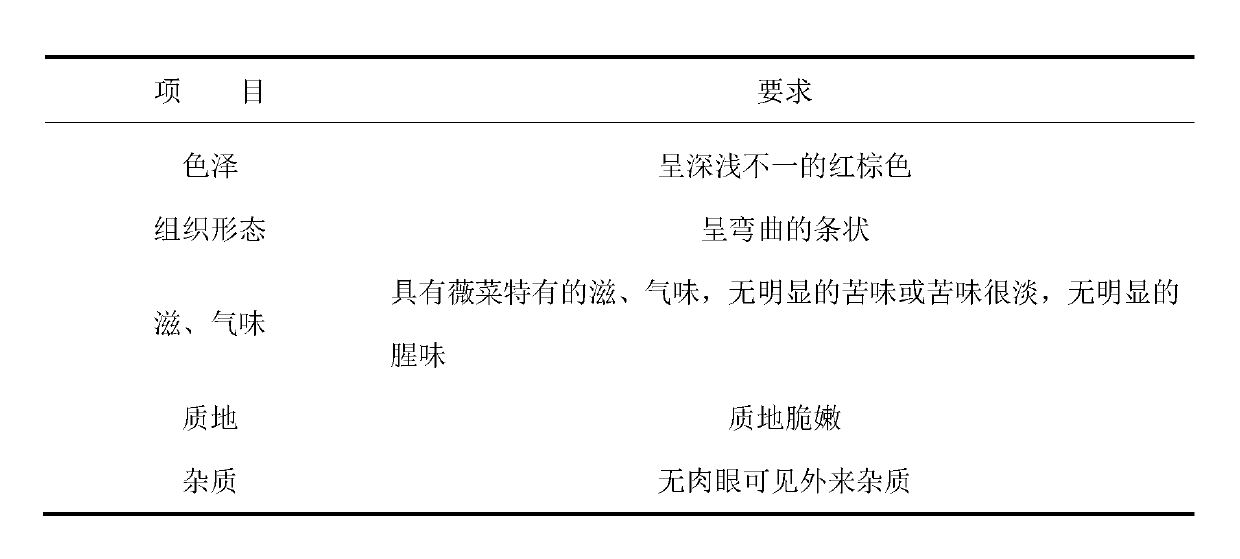Method for debittering and deodorizing rehydrated osmund head
A technology of removing bitterness from weed cabbage, which is applied in the fields of application, food preparation, food science, etc., to achieve the effects of ensuring stability, preserving nutritional value, and convenient operation
- Summary
- Abstract
- Description
- Claims
- Application Information
AI Technical Summary
Problems solved by technology
Method used
Image
Examples
Embodiment 1
[0033] (1) Raw material pretreatment
[0034] Choose dried kelp with complete organization, brown or brown-black, and remove the brown-yellow raw materials, velvet hairs and impurities visible to the naked eye;
[0035] (2) Rehydration
[0036] The dried scallops were placed in a constant temperature water bath at 60°C with a material-to-liquid ratio of 1:60. After rehydration for 2.5 hours, the water was changed once with a material-to-liquid ratio of 1:45, and the water temperature was also maintained at 60°C for 2.5h. Finally, make the rehydration ratio of Mirs reach 5.5, and the rehydration ratio=the weight of Mirs drained after rehydration / the weight of dried Mirs;
[0037] (3) Cutting, molding and grading
[0038] The above-mentioned rehydration was cut into a length of 3 cm, and the tip of the weed was separated from the middle of the weed, and the fibrous old stem tissue, soft and rotten texture, and defective products and foreign bodies at the bottom of the weed wer...
Embodiment 2
[0046] (1) Raw material pretreatment
[0047] Choose dried kelp with complete organization, brown or brown-black, and remove the brown-yellow raw materials, velvet hairs and impurities visible to the naked eye;
[0048] (2) Rehydration
[0049] The dried scallops were placed in a constant temperature water bath at 45°C, with a material-to-liquid ratio of 1:40. After rehydration for 3 hours, the water was changed once with a material-to-liquid ratio of 1:35, and the water temperature was also maintained at 45°C for 3 hours. The rehydration ratio of the swede reaches 5.0, and the rehydration ratio=the weight of the dried sage after rehydration / the weight of the dried sage;
[0050] (3) Cutting, molding and grading
[0051]The above-mentioned rehydration was cut into a length of 4 cm, and the tip of the weed was separated from the middle of the weed, and the fibrous old stem tissue at the bottom of the weed, the soft and rotten texture, and the defective products and foreign ob...
Embodiment 3
[0059] (1) Raw material pretreatment
[0060] Choose dried kelp with complete organization, brown or brown-black, and remove the brown-yellow raw materials, velvet hairs and impurities visible to the naked eye;
[0061] (2) Rehydration
[0062] The dried scallops were placed in a constant temperature water bath at 55°C, with a material-to-liquid ratio of 1:55. After rehydration for 2.8 hours, the water was changed once with a material-to-liquid ratio of 1:45, and the water temperature was also maintained at 55°C for 2.8h. Finally, the rehydration ratio of Mirs is reached to 5.4, and the rehydration ratio=the weight of Mirs drained after rehydration / the weight of dried Mirs;
[0063] (3) Cutting, molding and grading
[0064] The above-mentioned rehydration was cut into a length of 3.5 cm, and the tip of the weed was separated from the middle of the weed, and the fibrous old stem tissue, soft and rotten texture, and defective products damaged by diseases and insects were remov...
PUM
 Login to View More
Login to View More Abstract
Description
Claims
Application Information
 Login to View More
Login to View More - R&D
- Intellectual Property
- Life Sciences
- Materials
- Tech Scout
- Unparalleled Data Quality
- Higher Quality Content
- 60% Fewer Hallucinations
Browse by: Latest US Patents, China's latest patents, Technical Efficacy Thesaurus, Application Domain, Technology Topic, Popular Technical Reports.
© 2025 PatSnap. All rights reserved.Legal|Privacy policy|Modern Slavery Act Transparency Statement|Sitemap|About US| Contact US: help@patsnap.com



